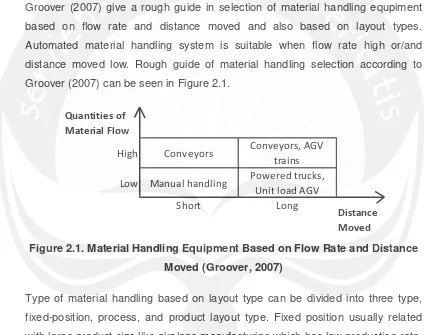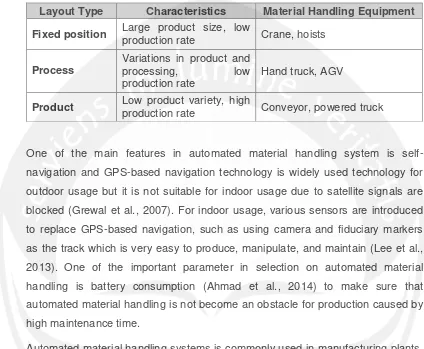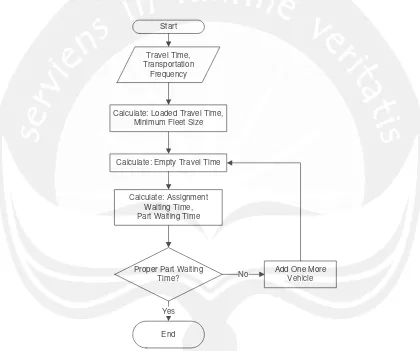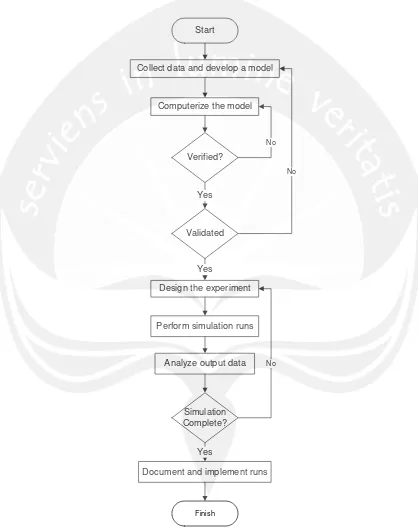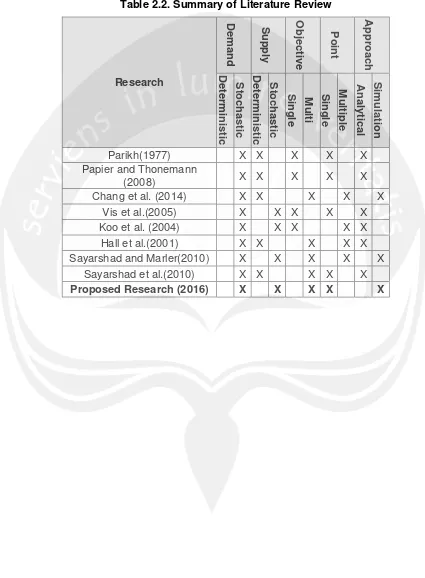6
CHAPTER 2
LITERATURE REVIEW AND THEORITICAL BACKGROUND
This chapter presents some previous researches and theoretical background in automated material handling system, fleet sizing, and economic profitability. Simulation approach and time study which are very useful for this research are also explained in this chapter. Finally, this research contributions over some previous researches are being explained in the last section
2.1. Automated Material Handling System
[image:1.595.88.512.272.607.2]Groover (2007) give a rough guide in selection of material handling equpiment based on flow rate and distance moved and also based on layout types. Automated material handling system is suitable when flow rate high or/and distance moved low. Rough guide of material handling selection according to Groover (2007) can be seen in Figure 2.1.
Figure 2.1. Material Handling Equipment Based on Flow Rate and Distance
Moved (Groover, 2007)
Type of material handling based on layout type can be divided into three type, fixed-position, process, and product layout type. Fixed position usually related with large product size like airplane manufacturing which has low production rate. Material handling that suitable for fixed position layout type can be cranes or hoists. Another layout type is process layout type which has characteristic in product variability and low production rates. Material handling equipment that suitable for process layout is hand trucks or AGV which have high flexibility in their routing. Last layout types is product layout which has limited product variability and high production rate. Conveyor or powered truck is suitable for
High Conveyors Conveyors, AGV trains Low Manual handling Powered trucks,
Unit load AGV
Short Long
Quantities of Material Flow
7
[image:2.595.87.511.170.519.2]product layout type. Summary of material handling equipment based on layout types can be seen in Table 2.1.
Table 2.1. Material Handling Equipment Based on Layout Type (Groover,
2007)
Layout Type Characteristics Material Handling Equipment
Fixed position Large product size, low
production rate Crane, hoists
Process
Variations in product and
processing, low
production rate
Hand truck, AGV
Product Low product variety, high
production rate Conveyor, powered truck
One of the main features in automated material handling system is self-navigation and GPS-based self-navigation technology is widely used technology for outdoor usage but it is not suitable for indoor usage due to satellite signals are blocked (Grewal et al., 2007). For indoor usage, various sensors are introduced to replace GPS-based navigation, such as using camera and fiduciary markers as the track which is very easy to produce, manipulate, and maintain (Lee et al., 2013). One of the important parameter in selection on automated material handling is battery consumption (Ahmad et al., 2014) to make sure that automated material handling is not become an obstacle for production caused by high maintenance time.
Automated material handling systems is commonly used in manufacturing plants, warehouses, distribution center, and trans-shipment terminals (Rinkacs et al., 2014). The purpose of automated material handling is to connect two stations that cannot be combined due to area constraint and space availability to reduce headcounts in production floor.
2.2. Fleet Sizing
8
material handling. In the beginning research, fleet sizing problems can be similar with queuing theory where fleet is treat as server in queuing theory (Parikh, 1977). Parikh (1977) gave adjustment in queuing model that has same behavior based on inter-arrival time. Situation on his research was automated material handling in flow shop with closed loop route and the objectives is to minimize waiting time of material. The research was continued by Papier and Thonemann (2008) to compared between queueing models and time-space models which is queuing models is more suitable for long term decision making, such as planning fleet sizes over the next years and time-space models is appropriate model to plan allocation for each fleet.
Too little fleet cannot satisfy the requirement, but too many fleet would be increase vehicle cost and traffic intensity (Chang et al., 2014). Chang et al. (2014) used simulation-based framework to find optimum fleet size under multi objective because one of the advantages of using simulation is user can treat some processes as a black box. Chang et al. (2014) use simulation due to complexity in automated material handling route. Another research found that analytical approach is found to be the best solution to determine minimum fleet size under time-window constraint (Vis et al., 2005)
Koo et al., (2004) done some research in fleet sizing for multiple pickup and delivery point with consideration of additional rules of nearest vehicle selection rule. Koo also shows the overall fleet sizing procedure which is shown in Figure 2.2.
To determine minimum fleet size, total vehicle travel time is divided by the length of available time of vehicle (Koo et al., 2004). Automated material handling design for closed loop flowshop already researched by Hall et al., (2001) and fleet sizing was based on minimum cycle time of processes that will not reduced anymore if one material handling was added.
9
2.3. Flow Shop and Queuing Model
Hard disk manufacturers can be classify as flow shop which has characteristic on limited product variability and high production rate. Buzacott & Shanthikumar (1993) breakdown flow shop into certain categories based on characteristic in flow shop. There are two categories based on operator policy in processing item, paced and unpaced lines. Paced lines is condition when cycle time of operator in every work center is fixed. Therefore, it is possible that operator not finish the task given. On the contrary, unpaced lines is condition when there is no limited cycle time of operator in doing their task.
Start
Travel Time, Transportation
Frequency
Calculate: Loaded Travel Time, Minimum Fleet Size
Calculate: Empty Travel Time
Calculate: Assignment Waiting Time, Part Waiting Time
Proper Part Waiting Time?
Add One More Vehicle No
[image:4.595.88.508.249.600.2]End Yes
Figure 2.2. Overall Fleet Sizing Procedure (Koo et al., 2004)
10
transfer line. Therefore, it can be modelled by an open tandem queueing network. Buzacott and Shanthikumar (1993) also explained when inter-arrival time is poisson distribution and processing time in each server is exponential distribution, it can be solved using queuing model M/M/c. If inter-arrival time is not poisson distribution and/or processing time is not exponential distribution, it can be solved using queuing model G/G/c. Allen-Cunneen aproximation usually gives good approximation for G/G/c system, but unfortunately extensive testing by Tanner give conclusion that the result of approximation are within 10% of true values (Winston & Goldberg, 2004).
Taha (1997) explained about notation in queuing network with general notation a/b/c:d/e/f where a and b are respectively represent of arrival time and service time, c is represent number of server, d is represent queue discipline, e and f are respectively represent of maximum number in system and size of calling source which is infinite or finite. Notation to represent arrival and service time are:
a. M = Markovian (Poisson) arrival or service time which is equivalently with exponential inter-arrival time or service time
b. D = Constant (Deterministic) time
c. Ek = Erlang or gamma distribution of time
d. GI = General (generic) distribution of inter-arrival time e. G = General (generic) distribution of service time
Taha (1997) also explained when queuing model arrival and departure time is not following Poisson distribution, the model will be very complex and it is advisable to use simulation approach.
2.4. Simulation Approach
Winston & Goldberg (2004) defined simulation as a method or tool to depict the operation of a real world system as it evolves over time. System is a collection of entities that act and interact toward the accomplishment of some logical end (Schmidt & Taylor, 1970). Taha (1997) divided two type of simulation model, which are static and dynamic.
a. Static: Representation of a system at a particular point in time b. Dynamic: Representation of system as it evolves over time
11
framework on simulation study, which is shown in Figure 2.3. However, it is not mandatory to use the same framework caused by overlap between some of the stages.There are a lot of simulation software. Kelton et al. (2006) gave information needed such as features and capabilities in using ARENA Simulation software.
Start
Collect data and develop a model
Computerize the model
Verified?
Validated Yes
Yes
Design the experiment
Perform simulation runs
Analyze output data
Simulation Complete?
Yes
Document and implement runs No
No
No
[image:6.595.89.507.175.703.2]Finish
12
Kelton et al. (2006) gave framework on analyzing simulation result based on time frame of simulation. There are two time frame of simulations, which are terminating and steady state. Problem occurred in terminating simulation when to determine number of replications. Approximation in determining number of replication can be seen in Equation 2.1.
n ≅z1-α/2 2 s2 h2
(2.1)
Where:
n = Number of replications z = Z-Value
α = Confidence interval
s = Sample standard deviation h = Half-width
Another easier approximation but slightly different can be seen in Equation 2.2.
n ≅n0h0 2
h2
(2.2)
Where:
n0 = Initial number of replications
h0 = Initial half-width
The approximation formula on replication number needed can be defined as same as central limit theory, which is stated that it is fairly good enough if n is large (Kelton et al., 2006). Another stage to be considered in simulation is verification and validation stage. Kelton et al. (2006) gave definition on verification and validation. Verification stage in simulation software is to detect any error in model or ensure simulation behaves as intended. Validation is defined as activity to ensure that the simulation behaves the same as the real situation. There should be one or more parameter that can be compared between real situation and simulation model.
2.5. Statistical Analysis
13
Therefore, statistical analysis is useful to prove the any significance difference between scenarios. There are various tools to prove any significance difference between samples, such as z-test or t-test if there are only two samples involve. The tools in statistical analysis to prove any significance difference between samples if there are more than two samples involve is Analysis of Variance (ANOVA) (Bluman, 2012). Bluman (2012) divide ANOVA become two, which are one-way and two-way based on number of factor influence in the model. ANOVA is based on hypothesis testing. Following hypothesis is used in ANOVA:
Ho: µ1 = µ2 = µ3= … = µn
H1: At least one µn is different
Where:
µn= Means of sampe n
ANOVA Analysis can be done using MINITAB Software and the result will be in p-value (Montgomery & Runger, 2010). Montgomery & Runger (2010) also explained definition of p-value, which is the smallest level of significance that lead to null hypothesis rejection. Based on definition of p-value, null hypothesis is rejected if p-value is smaller or equal than level of significance.
2.6. Economic Profitability
Parameter which mainly used by top management in considering to accept or reject investment offered by each division is called economic profitability. Sullivan et al. (2006) explained several method to calculate economic profitability such as: a. Present Worth (PW)
b. Future Worth (FW) c. Annual Worth (AW)
d. Internal Rate of Return (IRR) e. External Rate of Return (ERR) f. Payback Period
14
Simple payback period is the smallest value of θ. The longer breakeven point, the greater risk of investment for a project. For project where all investment done in initial period, the equation can be seen in Equation 2.3.
∑ Rk-Ek -I≥0 θ
k=1
(2.3)
Where:
Rk = Revenue at k period Ek = Expenses at k period I = Investment
However, payback period is not considering time value of money which is interesting to consider. Another method that popular in decision making on economic profitability analysis is Internal Rate of Return (IRR). IRR is a method on investment calculation compared between present value of investment and earnings in the future. To calculate IRR, Microsoft Excel can be used with formula that can be seen in Equation 2.4.
=IRR(Values,[guess]) (2.4.)
Where:
Values = Cash flow in certain period
Guess = Optional value of approximation IRR value
2.7. Time Study
To determine operator required in operating I-Trolley, cycle time of operator in operating I-Trolley is an important data. Therefore time study is needed in this research. Niebel & Freivalds (2003) determine steps in time study including: selecting the operator, analyzing the job, breaking down into elements, recording elapsed elemental values, performance rating the operator, assigning allowances, and working up the results.
15
sufficient enough when N’ smaller than sample size. The formula of N’ can be seen in Equation 2.5.
N'= [
k/s√N∑Xi2-(∑Xi)2 ∑Xi
]
2 (2.5.)
Where:
k = Coefficient of confidence level s = Precision level
N = Sample size Xi = Standard time
Uniformity test is to make sure that all data is in control or lies between upper control limit and lower control limit. The formula of control limit can be seen in Equation 2.6.
CL = X̅+3σx (2.6.)
Where:
CL = Control limit X̅ = Grand mean σx = Variance of Data
2.8. Research Contribution
16
[image:11.595.86.511.156.734.2]is not follows exponential distribution. The explanation of material inter-arrival time is explained in chapter 4. The summary of previous researches characteristic and research contribution can be seen in Table 2.2.
Table 2.2. Summary of Literature Review
Research D eman d S up ply O bjec tive P oint A pp roac h D eterm inis tic S toc ha sti c D eterm inis tic S toc ha sti c S ing le M ul ti S ing le M ul tip le A na lyti ca l S imul a tion
Parikh(1977) X X X X X Papier and Thonemann
(2008) X X X X X
Chang et al. (2014) X X X X X Vis et al.(2005) X X X X X Koo et al. (2004) X X X X X Hall et al.(2001) X X X X X Sayarshad and Marler(2010) X X X X X
Sayarshad et al.(2010) X X X X X
